8 Agriculture and Sustainability
Learning Objectives
After studying this chapter, you should be able to:
- Discuss how conventional agriculture affects ecosystems, economies, and human health
- Identify environmental effects of pesticides
- Recognize the relationship between exposure to persistent organic pollutants (POPs) and human health
- Explain alternative practices in farming and soil management
Conventional Agriculture
The prevailing agricultural system, variously called “conventional agriculture,” “modern agriculture,” or “industrial farming,” has delivered tremendous gains in productivity and efficiency. Food production worldwide has risen in the past 50 years; the World Bank estimates that between 70 percent and 90 percent of the recent increases in food production are the result of conventional agriculture rather than greater acreage under cultivation. U.S. consumers have come to expect abundant and inexpensive food.
Conventional farming systems vary from farm to farm and from country to country. However, they share many characteristics such as rapid technological innovation, large capital investments in equipment and technology, large-scale farms, single crops (monocultures); uniform high-yield hybrid crops, dependency on agribusiness, mechanization of farm work, and extensive use of pesticides, fertilizers, and herbicides (Figure 1).

In the case of livestock, most production comes from systems where animals are highly concentrated and confined. In the United States alone, over 10 billion land animals (cows, pigs, chickens, etc.) are used for food every year. Raising such a large number of animals on a limited amount of land requires animals to be housed in crowded, unsanitary conditions (Figure 2). This overcrowding can result in animal cruelty and the spread of diseases like bird flu to farm workers and their communities.
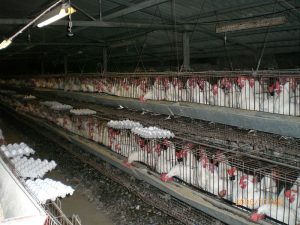
Both positive and negative consequences have come with the bounty associated with industrial farming. Some concerns about conventional agriculture are presented below.
Ecological Concerns
Agriculture profoundly affects many ecological systems. Negative effects of current practices include the following:
Decline in soil productivity can be due to wind and water erosion of exposed topsoil, soil compaction, loss of soil organic matter, water holding capacity, and biological activity; and salinization (increased salinity) of soils in highly-irrigated farming areas. Converting land to desert (desertification) can be caused by overgrazing of livestock and is a growing problem, especially in parts of Africa.
Agricultural practices have been found to contribute to non-point source water pollutants that include salts, fertilizers (nitrates and phosphorus, especially), pesticides, and herbicides. Pesticides from every chemical class have been detected in groundwater and are commonly found in groundwater beneath agricultural areas. They are also widespread in the nation’s surface waters. Eutrophication and “dead zones” due to nutrient runoff affect many rivers, lakes, and oceans. Reduced water quality impacts agricultural production, drinking water supplies, and fishery production. Water scarcity in many places is due to overuse of surface and ground water for irrigation with little concern for the natural cycle that maintains stable water availability.
Other environmental ills include over 400 insects and mite pests and more than 70 fungal pathogens that have become resistant to one or more pesticides. Pesticides have also placed stresses on pollinators and other beneficial insect species. This, along with habitat loss due to converting wildlands into agricultural fields, has affected entire ecosystems (such as the practice of converting tropical rainforests into grasslands for raising cattle).
Agriculture’s link to global climate change is just beginning to be appreciated. Destruction of tropical forests and other native vegetation for agricultural production plays a role in elevated levels of carbon dioxide and other greenhouse gases. In addition, cattle and sheep produce large amounts of the greenhouse gas methane as a result of their unique digestive processes.
Economic and Social Concerns
Economically, the U.S. agricultural sector includes a history of increasingly large federal expenditures. Also observed is a widening disparity among the income of farmers and the escalating concentration of agribusiness—industries involved with manufacture, processing, and distribution of farm products—into the hands of fewer and fewer corporations. Market competition is limited and farmers have little control over prices of their goods, and they continue to receive a smaller and smaller portion of consumer dollars spent on agricultural products.
Economic pressures have led to a tremendous loss to the number of farms, particularly small farms, and farmers during the past few decades. More than 155,000 farms were lost from 1987 to 1997. Economically, it is very difficult for potential farmers to enter the business today because of the high cost of doing business. Productive farmland also has been swallowed up by urban and suburban sprawl—since 1970, over 30 million acres have been lost to development.
Impacts on Human Health
Many potential health hazards are tied to farming practices. The general public may be affected by the use of antibiotics in animal production, as this can lead to the evolution of drug-resistant bacteria. Food and water may also be contaminated by pesticides and nitrates. The health of farm workers is also of concern, as farm work is often physically demanding and their risk of exposure to pesticides is much higher.
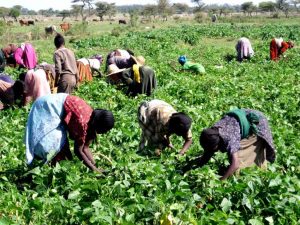
Philosophical Considerations
Historically, farming played an important role in our development and identity as a nation. From strongly agrarian roots, we have evolved into a culture with few farmers. Less than two percent of Americans now produce food for all U.S. citizens. Can sustainable and equitable food production be established when most consumers have so little connection to the natural processes that produce their food? What intrinsically American values have changed and will change with the decline of rural life and farmland ownership?
World population continues to grow. According to recent United Nations population projections, the world population will grow to 9.7 billion in 2050 and 11.2 billion in 2100. The rate of population increase is especially high in many developing countries. In these countries, the population factor, combined with rapid industrialization, poverty, political instability, and large food imports and debt burden, make long-term food security especially urgent.
Pests and Pesticides
Pests are organisms that occur where they are not wanted or that cause damage to crops or humans or other animals (Figure 4). Thus, the term “pest” is a highly subjective term. A pesticide is a term for any substance intended for preventing, destroying, repelling, or mitigating any pest. Though often misunderstood to refer only to insecticides, the term pesticide also applies to herbicides, fungicides, and various other substances used to control pests. By their very nature, most pesticides create some risk of harm—pesticides can cause harm to humans, animals, and/or the environment because they are designed to kill or otherwise adversely affect living things. At the same time, pesticides are useful to society because they can kill potential disease-causing organisms and control insects, weeds, worms, and fungi.
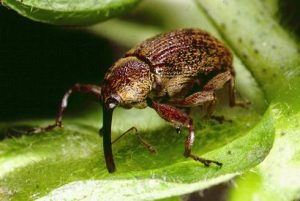
Pest Control
The management of pests is an essential part of agriculture, public health, and maintenance of power lines and roads. Chemical pest management has helped to reduce losses in agriculture and to limit human exposure to disease vectors, such as mosquitoes, saving many lives. Chemical pesticides can be effective, fast acting, adaptable to all crops and situations. When first applied, pesticides can result in impressive production gains of crops. However, despite these initial gains, excessive use of pesticides can be ecologically unsound, leading to the destruction of the natural enemies of pests, the increase of pesticide resistance in the pests themselves, and outbreaks of secondary pests.
These consequences have often resulted in higher production costs as well as environmental and human health costs—side-effects which have been unevenly distributed. Despite the fact that the lion’s share of chemical pesticides are applied in developed countries, 99 percent of all pesticide poisoning cases occur in developing countries where regulatory, health and education systems are weakest. Many farmers in developing countries overuse pesticides and do not take proper safety precautions because they do not understand the risks and fear smaller harvests. Making matters worse, developing countries seldom have strong regulatory systems for dangerous chemicals; pesticides banned or restricted in industrialized countries are used widely in developing countries. Farmers’ perceptions of appropriate pesticide use vary by setting and culture. Prolonged exposure to pesticides has been associated with several chronic and acute health effects like non-Hodgkin’s lymphoma, leukemia, as well as cardiopulmonary disorders, neurological and hematological symptoms, and skin diseases.
Knowledge Check
|
BOX 1. HUMAN HEALTH, ENVIRONMENTAL, AND ECONOMIC EFFECTS OF PESTICIDE USE IN POTATO PRODUCTION IN ECUADOR |
|---|
|
The International Potato Center (CIP) conducted an interdisciplinary and inter-institutional research intervention project dealing with pesticide impacts on agricultural production, human health, and the environment in Carchi, Ecuador. Carchi is the most important potato-growing area in Ecuador, where smallholder farmers dominate production. They use tremendous amounts of pesticides for the control of the Andean potato weevil and the late blight fungus. Virtually all farmers apply class 1b highly toxic pesticides using hand pump backpack sprayers. The study found that the health problems caused by pesticides are severe and are affecting a high percentage of the rural population. Despite the existence of technology and policy solutions, government policies continue to promote the use of pesticides. The study conclusions concurred with those by the pesticide industry, “that any company that could not ensure the safe use of highly toxic pesticides should remove them from the market and that it is almost impossible to achieve safe use of highly toxic pesticides among small farmers in developing countries.” Source: Yanggen et al. 2003. |
POPs
Persistent organic pollutants (POPs) are a group of organic chemicals, such as DDT, that have been widely used as pesticides or industrial chemicals and pose risks to human health and ecosystems. POPs have been produced and released into the environment by human activity. They have the following three characteristics:
Persistent: POPs are chemicals that last a long time in the environment. Some may resist breakdown for years and even decades while others could potentially break down into other toxic substances.
Bioaccumulative: POPs can accumulate in animals and humans, usually in fatty tissues and largely from the food they consume. As these compounds move up the food chain, they concentrate to levels that could be thousands of times higher than acceptable limits.
Toxic: POPs can cause a wide range of health effects in humans, wildlife and fish. They have been linked to effects on the nervous system, reproductive and developmental problems, suppression of the immune system, cancer, and endocrine disruption. The deliberate production and use of most POPs has been banned around the world, with some exemptions made for human health considerations (e.g., DDT for malaria control) and/or in very specific cases where alternative chemicals have not been identified. However, the unintended production and/or the current use of some POPs continue to be an issue of global concern. Even though most POPs have not been manufactured or used for decades, they continue to be present in the environment and thus potentially harmful. The same properties that originally made them so effective, particularly their stability, make them difficult to eradicate from the environment.
POPs and Health
The relationship between exposure to environmental contaminants such as POPs and human health is complex. There is mounting evidence that these persistent, bioaccumulative and toxic chemicals (PBTs) cause long-term harm to human health and the environment. Drawing a direct link, however, between exposure to these chemicals and health effects is complicated, particularly since humans are exposed on a daily basis to many different environmental contaminants through the air they breathe, the water they drink, and the food they eat. Numerous studies link POPs with a number of adverse effects in humans. These include effects on the nervous system, problems related to reproduction and development, cancer, and genetic impacts. Moreover, there is mounting public concern over the environmental contaminants that mimic hormones in the human body (endocrine disruptors).
As with humans, animals are exposed to POPs in the environment through air, water and food. POPs can remain in sediments for years, where bottom-dwelling creatures consume them and who are then eaten by larger fish. Because tissue concentrations can increase or biomagnify at each level of the food chain, top predators (like largemouth bass or walleye) may have a million times greater concentrations of POPs than the water itself. The animals most exposed to the contaminants are those higher up the food web such as marine mammals including whales, seals, polar bears, and birds of prey, in addition to fish species such as tuna, swordfish and bass (Figure 5). Once POPs are released into the environment, they may be transported within a specific region and across international boundaries transferring among air, water, and land.
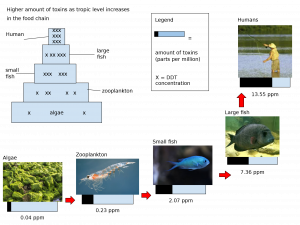
Knowledge Check
Sustainable Agriculture
Sustainable agriculture was addressed by Congress in the 1990 Farm Bill. Under that law, “the term sustainable agriculture means an integrated system of plant and animal production practices having a site-specific application that will, over the long term:
- satisfy human food and fiber needs;
- enhance environmental quality and the natural resource base upon which the agricultural economy depends;
- make the most efficient use of nonrenewable resources and on-farm resources and integrate, where appropriate, natural biological cycles and controls;
- sustain the economic viability of farm operations; and
- enhance the quality of life for farmers and society as a whole.”
Organic Farming
Organic farming is an ecological production management system that promotes and enhances biodiversity, biological cycles and soil biological activity. Organic food is produced by farmers who emphasize the use of renewable resources and the conservation of soil and water to enhance environmental quality for future generations. Organic meat, poultry, eggs, and dairy products come from animals that are given no antibiotics or growth hormones. Organic food is produced without using most conventional pesticides, fertilizers made with synthetic ingredients or sewage sludge, or genetically modified organisms (GMOs). The term “organic” in this sense is different from the way it is used by chemists to mean a compound that contains carbon.
Organic production, with the corresponding practices to maintain soil fertility and soil health can be a more sustainable alternative to conventional, high-value agriculture. The organic food movement has been endorsed by the UN’s Food and Agricultural Organization, which maintains in a 2007 report that organic farming fights hunger, tackles climate change, and is good for farmers, consumers, and the environment. The strongest benefits of organic agriculture are its use of resources that are independent of fossil fuels, are locally available, incur minimal environmental stresses, and are cost effective.
However, there are trade-offs that come with the use of organic farming. Organic food is often more expensive than conventionally grown food, so it may not be available to less affluent consumers. And because organic methods are less efficient than conventional farming, organic farms often require more land.
Integrated Pest Management
Integrated Pest Management (IPM) refers to a mix of farmer-driven, ecologically-based pest control practices that seeks to reduce reliance on synthetic chemical pesticides. It involves (a) managing pests (keeping them below economically damaging levels) rather than seeking to eradicate them; (b) relying, to the extent possible, on non-chemical measures to keep pest populations low; and (c) selecting and applying pesticides, when they have to be used, in a way that minimizes adverse effects on beneficial organisms, humans, and the environment. It is commonly understood that applying an IPM approach does not necessarily mean eliminating pesticide use, although this is often the case because pesticides are often over-used for a variety of reasons.
The IPM approach regards pesticides as mainly short-term corrective measures when more ecologically based control measures are not working adequately (sometimes referred to as using pesticides as the “last resort”). In those cases when pesticides are used, they should be selected and applied in such a manner as to minimize the amount of disruption that they cause to the environment, such as using products that are non-persistent and applying them in the most targeted way possible).
Biological Control
Biological control (biocontrol) is the use of one biological species to reduce populations of a different species. There has been a substantial increase in commercialization of biocontrol products, such as beneficial insects, cultivated predators and natural or non-toxic pest control products. Biocontrol is being mainstreamed to major agricultural commodities, such as cotton, corn and most commonly vegetable crops. Biocontrol is also slowly emerging in vector control in public health and in areas that for a long time mainly focused on chemical vector control in mosquito/malaria—and black fly/onchocerciasis—control programs. Successful and commercialized examples of biocontrol include ladybugs to depress aphid populations, parasitic wasps to reduce moth populations, use of the bacterium Bacillus thuringenensis to kill mosquito and moth larvae, and introduction of fungi, such as Trichoderma, to suppress fungal-caused plant diseases, leaf beetle (Galerucella calmariensis) to suppress purple loosestrife, a noxious weed. In all of these cases, the idea is not to completely destroy the pathogen or pest, but rather to reduce the damage below economically significant values.
Intercropping
Most modern farms rely on monoculture, or a single crop grown in one large area, to improve efficiency of production. Monocultures are easier to plant and harvest and they can be precisely targeted with pesticides and fertilizers. However, monocultures have led to a decrease in biodiversity and soil quality. In contrast, sustainable farming often relies on intercropping, or growing two or more crops in close proximity to each other during part or all of their life cycles. This method may promote soil improvement, biodiversity, and less harmful pest management. Incorporating intercropping principles into an agricultural operation increases diversity and interaction between plants, arthropods, mammals, birds and microorganisms resulting in a more stable crop-ecosystem and a more efficient use of space, water, sunlight, and nutrients (Figure 7). This collaborative type of crop management mimics nature and is subject to fewer pest outbreaks, improved nutrient cycling and crop nutrient uptake, and increased water infiltration and moisture retention. Soil quality, water quality and wildlife habitat all benefit.
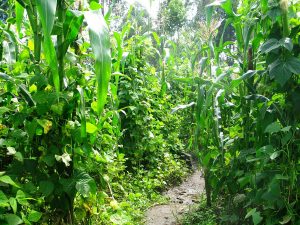
Knowledge Check
Crop Rotation
Crop rotations are planned sequences of crops over time on the same field. Rotating crops provides productivity benefits by improving soil nutrient levels and breaking crop pest cycles. Farmers may also choose to rotate crops in order to reduce their production risk through diversification or to manage scarce resources, such as labor, during planting and harvesting timing. This strategy reduces the pesticide costs by naturally breaking the cycle of weeds, insects and diseases. Also, grass and legumes in a rotation protect water quality by preventing excess nutrients or chemicals from entering water supplies.
| BOX 2. AN ALTERNATIVE TO SPRAYING: BOLLWORM CONTROL IN SHANDONG |
|---|
|
Farmers in Shandong, China have been using innovative methods to control bollworm infestation in cotton when this insect became resistant to most pesticides. Among the control measures implemented were:
These and some additional biological control tools have proved to be effective in controlling insect populations and insect resistance, protecting surroundings and lowering costs. |
Knowedge Check
Summary
Conventional agriculture has dramatically increased global food production and made food more affordable, but it has also brought serious environmental, social, and health challenges. Heavy reliance on chemical inputs, monocultures, and confined animal operations has degraded soil, polluted water, contributed to climate change, and harmed ecosystems. Farmers face economic pressures from agribusiness consolidation, while farmworkers and consumers encounter health risks from pesticide exposure and antibiotic use. As the global population continues to grow, the need to balance productivity with sustainability becomes more urgent. Approaches such as organic farming, integrated pest management, and biological control offer promising alternatives that protect natural resources and support long-term food security. The future of agriculture depends on finding solutions that meet human needs while preserving the health of the planet.
Attribution
Essentials of Environmental Science by Kamala Doršner is licensed under CC BY 4.0. Modified from the original by Matthew R. Fisher and Sean Whitcomb
Media Attributions
- Cotton Harvest © Kimberly Vardeman is licensed under a CC BY (Attribution) license
- 800px-Industrial-Chicken-Coop © ITamar K. is licensed under a Public Domain license
- farmer-workers-in-ethiopia-725×544 © Kristina Stefanova is licensed under a Public Domain license
- cotton_boll_weevil © Jimmy Smith is licensed under a CC BY-NC-ND (Attribution NonCommercial NoDerivatives) license
- The build up of toxins in a food chain © Rohats is licensed under a CC BY-SA (Attribution ShareAlike) license
- Intercropping_maize_and_beans © AnnaJB is licensed under a CC BY-SA (Attribution ShareAlike) license

